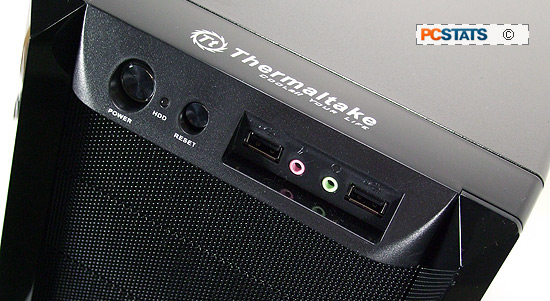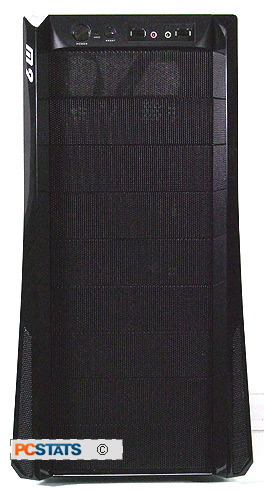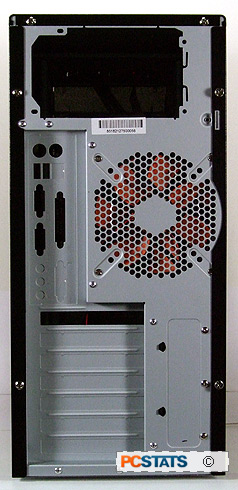The front panel and triangular side fins on the M9 case are
made from separate pieces of plastic, one shiny the other matt. The bezels don't match
up either, so that the roughed plastic tapers inwards as the triangular sides flare
outwards - the effect makes it seem like Thermaltake just had a bunch of generic
front control panels lying around, instead of molding ones specifically to match
up with the M9's look.
|

|
The front of the M9 case is completely aluminum
mesh from top to bottom, over the 9 available bays. The mesh itself is good for
case airflow, sort of like the Cooler Master HAF
932 PCSTATS reviewed recently (though that beast is in a higher
class for sure). While I personally prefer having exposed bays as opposed to cases with
doors -- exposed bays allow you to mount and access exotic card readers and
temperature gauges -- the Thermaltake M9's uniform front mesh seems uninspired. Even with
its blue LED illuminated hard drive cage fan lighting up the bottom third of the chassis,
the M9 would do well with some markings on the front to break up the monotony. Dare I
say it, this Thermaltake case needs a Thermaltake logo or something... ninja's perhaps?
|
 
|
The side triangular fins are perhaps my least favorite fashion choice. Like Enermax's Phoenix , the Thermaltake M9 swells at the bottom
with a pair of triangular sidings that serve no purpose. The grills on the
side make them look a little like air intakes on a stealth bomber, but
they are not.
While the windowed version of the Thermaltake M9 would likely be more interesting
I think. The steel is a bit flimsy, but at least it's held on with
thumbscrews.
Inside the M9 you'll find the usual - a top space for a single or dual-fan power supply,
a rear 120mm exhaust fan with a molex pass-through, an included I/O shield that
will always vary slightly from your motherboard configuration, forcing you to
pop it out, and seven tool-free PCI slots.
Motherboard installation is fairly simple, there are six included stand-offs that line up with standard ATX holes.
Once the included I/O shield has been removed, the unit supplied with the motherboard
can be popped in along with the board. The motherboard tray
isn't removable, so if you're using a back-plate design CPU heatsink, make sure
to put the back plate on first before you secure the motherboard to the case and
start adding in components.
Thermaltake decided to mount its hard drive bays
parallel with the PCI slots of the motherboard, and since the case isn't all
that deep (it's 19.5 inches, standard for a mid-tower), it may be problematic
with larger PCI Express videocards like the Radeon HD 4870
X2 . Graphics cards over 12" in length simply won't fit
if hard drives are installed next to them.
The solution that the Thermaltake M9 provides to get around this problem
is a three-bay hard drive cage, which can be slotted into any of the nine
5.25" slots that run from the top of the chassis to the bottom. This gives a
little more flexibility, as users can leave their video cards in the middle of
the case, and then put their hard drives near the top, although solution will
definitely make more for more tricky cabling.
More importantly though, there's only three available
hard drive bays? Really? Even no-name OEM boxes give more space to expand than
that. Users who want to run RAID
1/0 or simply mount old drives inside this case will have to get more cages
from Thermaltake or use an external HDD system like
this.
